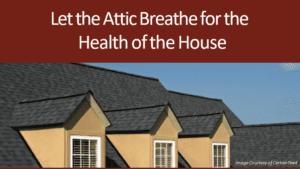Revised November 2023
By Asphalt Roofing Manufacturers Association (ARMA)

Attics are often overlooked and may be viewed by homeowners as just another place to store excess boxes of clothes and decorations.
This is a mistake because, if not properly ventilated, an attic space can negatively affect energy bills, roofing shingles, insulation, and indoor air quality.
When the sun hits the roof of a home during the summer months, the heat is absorbed into the attic. Without proper ventilation, the heat can radiate into the living space below, causing air conditioners, fans, refrigerators, and other appliances to work harder.
In this scenario, proper ventilation cools the home and can lead to reduced energy bills.
Proper ventilation is also important in the winter when moisture is a primary concern. The daily activities of an average family of four generate approximately two to four gallons of water vapor. This vapor rises to the colder and dryer attic, where it can condense if not properly vented, leading to the dampening of the attic insulation. Damp insulation can cause wood rot, mold, and mildew, leading to poor indoor air quality in the rest of the home.
Poor ventilation can also affect the exterior of a home. In the winter, warm areas on a roof can lead to snowmelt and the formation of ice dams.
Ice Dams are formed in colder climates when heat bypasses insulation through light fixtures or exhaust systems, creating warm areas on the roof and melting an area of snow. This leads to the melted snow flowing down the roof until it hits a colder spot, where it refreezes and causes a back-up of ice on certain parts of the roof. Proper attic ventilation can remove the heated air from the attic and prevent ice damming in the winter before it becomes a hazard.
Did You Know?
- The average family of four generates approximately two to four gallons of water vapor each day through activities such as breathing, perspiration, showers, cooking, and dishwashing.
- Improper ventilation can lead to premature deterioration of your shingles and roof deck.
- Proper ventilation means your attic stays cooler, reducing the load on your AC system
- A balanced ventilation system occurs when intake ventilation at the eave areas is equal to exhaust ventilation at or near the ridge area.
Excessive moisture and heat build-up can also cause the shingles and decking of your roof to deteriorate prematurely. Proper ventilation of the attic space reduces moisture and lowers the surface temperature of the roof.
“The best way to achieve balanced ventilation in your attic is to create continuous airflow along the entire underside of the roof sheathing. The flow of air from the lower portion to the upper portion operates like a chimney and is referred to as the “stack effect.”
Here are a few tips for avoiding common mistakes that homeowners, and even contractors, might make when installing a ventilation system:
- Check that intake vents are not covered with insulation or painted closed.
- If necessary, install attic insulation baffles to keep the insulation from blocking the intake vents.
- Use only one type of exhaust vent on the same roof of a common attic to avoid possible short-circuiting of the airflow.
About Aaron R. Phillips
 Aaron R. Phillips
Aaron R. Phillips
ARMA Vice President of Technical Services
“My goal is to advocate and advance the technical interests of the asphalt roofing industry.”
Aaron R. Phillips, ARMA Vice President of Technical Services, has worked in the asphalt roofing industry since 1988. Phillips serves as ARMA’s primary technical voice, assuring that asphalt roofing is accurately, equitably, and appropriately represented in all scientific and technical discussions regarding residential and commercial roofing applications. He manages all of ARMA’s technical-related activities and also serves as the association’s technical liaison to organizations involved in the development of building standards. Phillips has been active in various industry organizations throughout his career, including more than 25 years of service as an ARMA volunteer.
Why Choose Asphalt Shingles?
Beautiful, Affordable, Reliable
About ARMA
The Asphalt Roofing Manufacturers Association (ARMA) is a trade association representing
North America’s asphalt roofing manufacturing companies and their raw material suppliers. The association includes the majority of North American manufacturers of asphalt shingles and asphalt low-slope roof membrane systems. Committed to advances in the asphalt roofing industry, ARMA is proud of the role it plays in promoting asphalt roofing to those in the building industry and the public.
For more information about ARMA, visit asphaltroofing.org.
![]()
2331 Rock Spring Road · Forest Hill, MD 21050 · www.asphaltroofing.org
A member service provided by the Asphalt Roofing Manufacturers Association


